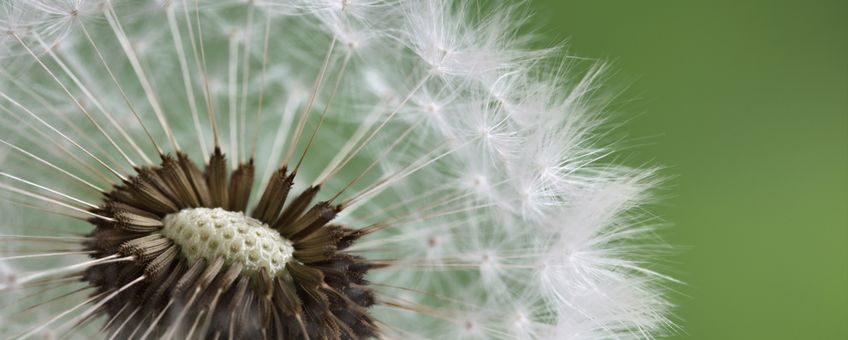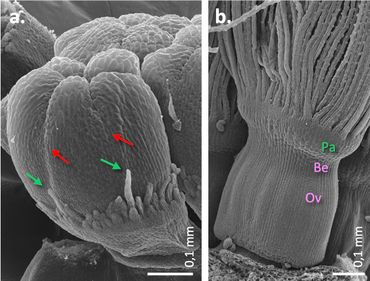
How does the dandelion adapt to cities and what is the pappus’ role in this?
Naturalis Biodiversity CenterTo find out how dandelions adapt to their environment, we first need to acquire a thorough understanding of the plant’s structure and development. Therefore, the researchers made a detailed study of the dandelion.
Composite flower heads
 Dandelions (Fig. 1a) belong to the Asteraceae, flowering plants with composite flower heads. In the Asteraceae, the flower heads are compressed, so to speak, into a ‘flat surface’, the receptacle, on which a large number of small flowers are placed. These small flowers are called ‘florets’. A single dandelion head can easily contain between 120 and 200 florets (Fig. 1b). One floret (Fig. 1c) consists of an inferior ovary, the pappus, the five petals, five stamens with the anthers, and the style with two stigmas. In dandelions, the petals are fused into a ribbon, the ‘ligule’. This is also found in related species such as lettuce and chicory. In another group of Asteraceae, the petals are fused into a tube, often with one or a few rows of ray florets at the edge of the flower head, as in the sunflower.
Dandelions (Fig. 1a) belong to the Asteraceae, flowering plants with composite flower heads. In the Asteraceae, the flower heads are compressed, so to speak, into a ‘flat surface’, the receptacle, on which a large number of small flowers are placed. These small flowers are called ‘florets’. A single dandelion head can easily contain between 120 and 200 florets (Fig. 1b). One floret (Fig. 1c) consists of an inferior ovary, the pappus, the five petals, five stamens with the anthers, and the style with two stigmas. In dandelions, the petals are fused into a ribbon, the ‘ligule’. This is also found in related species such as lettuce and chicory. In another group of Asteraceae, the petals are fused into a tube, often with one or a few rows of ray florets at the edge of the flower head, as in the sunflower.
Hairy pappus
Dandelions contain a ‘hairy’ pappus, which unfolds like a parachute on a mature seed (Fig. 1c, insert), ideal for wind dispersal. There are also Asteraceae in which the pappus is more scale-like, making it suitable for dispersal by animals. The pappus therefore plays an important role in seed dispersal. As a result, changes in the pappus can affect the dispersal capacity.
The pappus is located where the sepals are usually placed in individual flowers. These alternate with respect to the five petals. The sepals protect the flower against influences from the environment. However, this is no longer necessary in the florets of the Asteraceae, because these are already protected by the bracts that surround the entire bud (Fig. 1b). As a result of the disappearance of their function, the sepals themselves may also disappear or acquire another function. “It is generally assumed that the pappus originates from the sepals, but this has scarcely been investigated, and there are also other theories about it”, says Naturalis researcher Kitty Vijverberg. “Our morphological and molecular research supports that the pappus indeed has been derived from the sepals”, Vijverberg says.
Effective wind dispersal
 “Interestingly, we found that the pappus hairs that grow at the position alternating with that of the petals, where the sepals are expected, were ahead in their growth (Fig. 2a). We also found that the pappus initiates as a ring via cell divisions in the outer cell layer, at the base of the petals (Fig. 2a). This ring is pronounced during development (Fig. 2b), and contains the pappus hairs. We interpret this as a modified calyx in the outer whorl or, in other words, the first whorl”, explains Vijverberg.
“Interestingly, we found that the pappus hairs that grow at the position alternating with that of the petals, where the sepals are expected, were ahead in their growth (Fig. 2a). We also found that the pappus initiates as a ring via cell divisions in the outer cell layer, at the base of the petals (Fig. 2a). This ring is pronounced during development (Fig. 2b), and contains the pappus hairs. We interpret this as a modified calyx in the outer whorl or, in other words, the first whorl”, explains Vijverberg.
Besides the pappus, the dispersal unit of dandelions consists of the beak (Figs 1c and 2b). The beak is a part of the ovary, which develops from the innermost floral whorl, the fourth whorl. Vijverberg: “This means that the dispersal unit is a composite organ of which the pappus forms before seed development (Fig. 1c) and the beak during seed development (Fig. 1c, insert).” The dandelion’s superb wind dispersal characteristics have therefore arisen due to both a hairy pappus and an unusual fusing of two flower organs.
“We made another interesting observation regarding the inferior ovary. It has since long been a question how the floral organs are attached to the receptacle in case of an inferior ovary. The idea is that the lower parts of the outer three floral whorls, representing the sepals, petals and stamen, are fused and proceeded along the ovary to the receptacle, which is below the inferior ovary. Alternatively, the receptacle should have moved up to the floral organs. Our morphological results, together with published results on lettuce, support the second theory. A nice figure of this can be found in the supplementary part of our paper”, Vijverberg concludes.
Back to the city
From this study, it doesn't become clear yet whether dandelion seeds either fall close by or far away from the mother plant to have the best chance of survival. However, now we know how the dispersal unit is built-up we can start to measure changes, first morphologically and then molecularly. We've already seen a trend towards shorter pappus hairs, a shorter rostrum and heavier seed in dandelions in the city which means that they fall closer to the parent plant. Currently it is being explored in a larger scale experiment whether this is consistent and holds under different city conditions.
More information
- The entire article entitled 'Sepal identity of the pappus and floral organ development in the common dandelion (Taraxacum officinale; Asteraceae)' can be read here.
Text: Kitty Vijverberg, Naturalis Biodiversity Center
Images: Naturalis Biodiversity Center; Kitty Vijverberg
